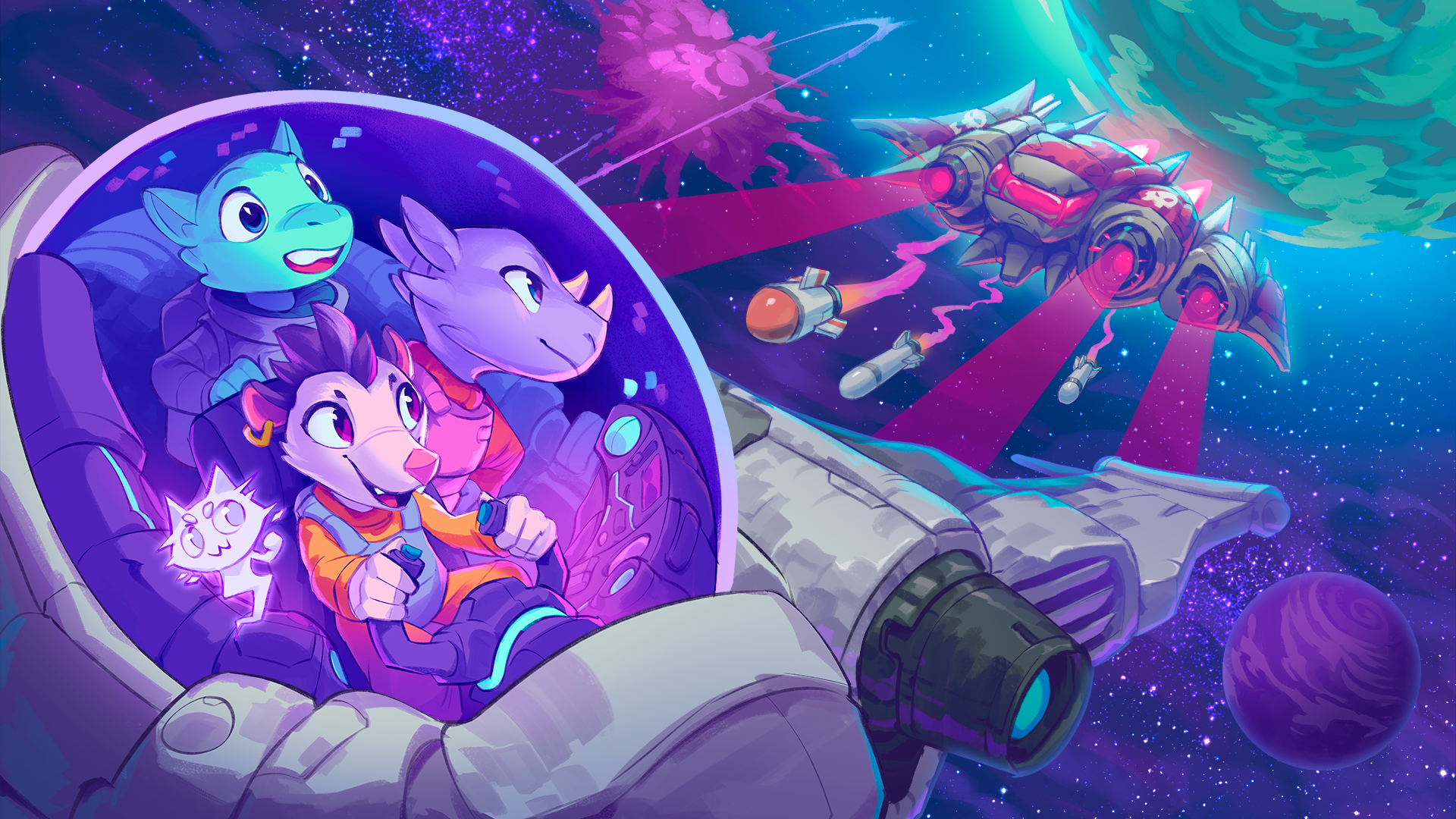Get ready to be looped into the next turn-based game that clashes FTL: Faster Than Light with Slay the Spire. This is the type of game that I always wished FTL would be. Cobalt Core is a sci-fi roguelike deckbuilder with a new tactical spin. But is it any good? Let’s jump in and find out.
In this Cobalt Core Review, I will be going over:
Story
You start your first run with Dizzy, Riggs, and Peri as they get woken up out of cryosleep by the computer. The ship is under attack, and there is no time to waste. Not even enough time to fully restore their memories. Quickly, your team gets to their stations to take down the enemy ship. Now, they must continue, hoping that their memories return as they adventure through another time loop.

Gameplay
Cobalt Core, like many other roguelites deckbuilders, revolves around two key elements. Those are, of course, card-based combat and progressing across a branching map to get to the final boss. During your journey you will pick up cards, artifacts, and even meet a few interesting characters along the way.
Let’s talk a little bit about the setup and map first. Afterwards, we will get into the combat and the different types of cards you might find.
Setup
Before the start of every run, you will need to select your crew and your ship. You will also be selecting the level of difficulty. Both the crew and the ships will slowly unlock as you play. Some unlock over time, while others have specific requirements.
Crew
Currently there are eight different slots for selectable crew members. You will always take three on each run with you. That is something like 56 possible crew combinations. That’s a lot of built-in replayability.

Each member of the crew has a very different personality and an even more unique selection of cards. All of the characters interact with each other and the environment. The side conversations between the crew and other characters you come across, are always comical. Sometimes even insightful. They also remember events that happened earlier in your run. More on that later though.
The starting three characters have the standard cards set of shields, mobility, and weapons. After that though, some of the card sets are quite unique. They even add new elements to the game such as drones and an overheating mechanism. A big part of the game is just experimenting with all the different synergies between the crew members and the ship they are flying in.
Ships
Cobalt Core has 5 different ships to select from. Combine that with all the different crew configurations and you have nearly an endless supply of options to choose from. Yet, I still have my fingers crossed that they add more. I want to see what else those creative minds over at Rocket Rat Games can come up with.
Each ship is very different from the others. The first ship has just a single cannon and missile bay. Things quickly get exciting from there, though. The next ship you unlock has 2 cannon slots, but only one is active at a time. It comes with a card that allows you to switch the cannon back and forth. This can create some interesting strategies when trying to target weak points in an enemy ship without moving.
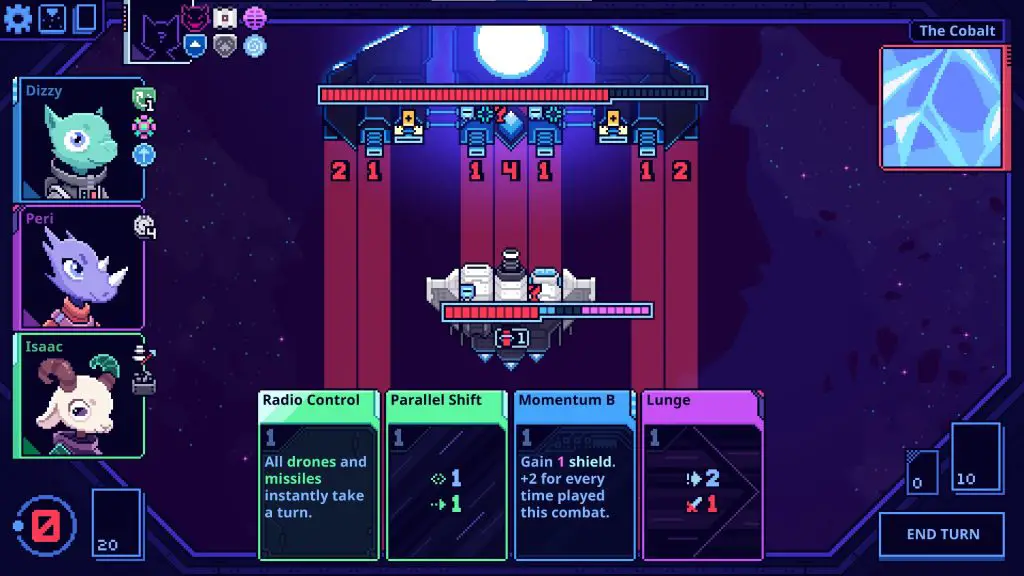
One of my favorite ships relies strictly on drones. It has no cannons on board. All of your attack cards activate the specialized drones that use that attack as its own. This can be pretty tricky if you have an enemy that keeps shooting down your drones every turn. However, it also creates some very satisfying turns when you have three or more drones all doing the same powerful attacks.
Difficulty
The final step before starting a run is setting the difficulty level. In Cobalt Core, there are 4 different levels of difficulty. These are labeled as Normal, Hard, Harder, and Hardest. As you go up in difficulty, not only do the enemies become more challenging, but your ship starts with less health, and you get fewer victory rewards per combat.
Map
Just like most other roguelites, Cobalt Core has a randomly generated branching map for you to navigate. There are a handful of different nodes that you will come across on your journey through the 3 different zones. Here is a brief description of the different nodes:
- Repair Yard – You can repair your ship, remove cards, or upgrade cards.
- Events – These nodes include a variety of random events which I will go more into next.
- Artifacts – Usually these nodes have a single random artifact that you can obtain to help you on your journey.
- Combat – These nodes include common and elite battles with an award of cards or cards and an artifact. There is also a boss fight at the end of each zone.
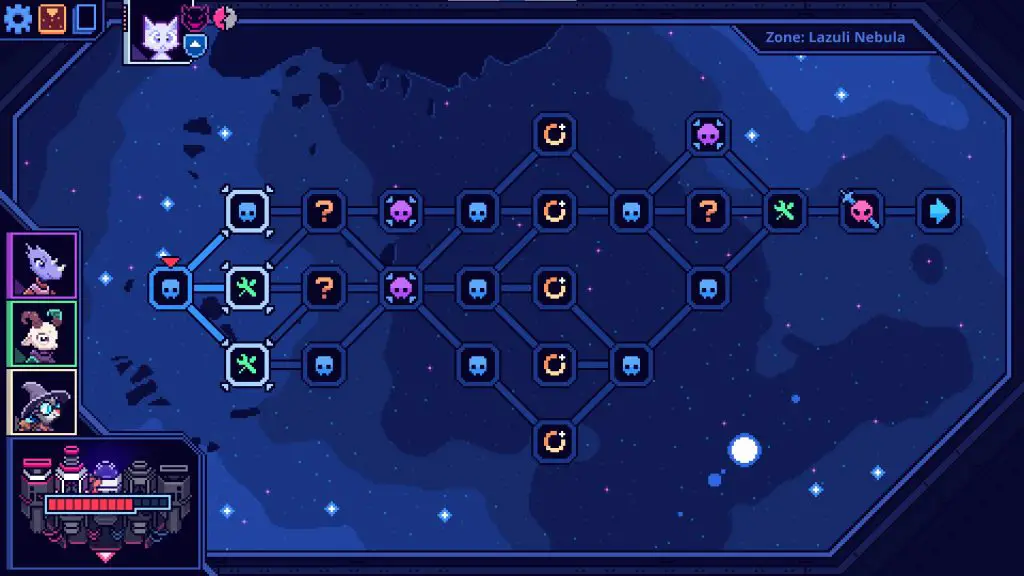
Events
The event nodes in Cobalt Core were something that I sought out in my first several runs. This was because I found several of them quite entertaining. Some of them are simply talking to a character to get an artifact. Others are a bit more interesting though.
One of my favorite events really changed up the combat. This poor frog had lost control of his rockets. They were all firing backward at his own ship. He asks for your help to stop the rockets while he tries to disable them on his end. If you have a drone specialist in your crew, then it is a pretty easy task. However, without the ability to control the middle row and move the rockets away from the frog’s ship, things get quite interesting. You have to maneuver your own ship around and try to shoot down all the rockets instead.
If you can successfully save the poor frog, then he offers you an artifact or his rockets. I typically take the rockets. When using them later, sometimes the crew will comment about thanking the frog for giving us the rockets to use. Little side comments referring to past events are the little details that I really enjoy in games.
Since I sought out all the events in my first several runs, I am pretty sure I have seen them all by now. Hopefully, they add more in a future content update. I would love to see what other creative events the developers have in mind.

Combat
Now for the part, I am sure a lot of people have been waiting for. Let’s dig into the combat. We will see if this is just another generic deckbuilder or if there is something here that makes it stand out.
In Cobalt Core, there are three different rows on the combat screen. The top row is where the enemy ship is. There is a middle row, or mid-row, which various items can occupy. Lastly, the bottom row is where your ship is.
Top Row
At the top row, the enemy ship is labeled with its health and shields, along with any status effects it might have. The ship will also display any actions it will take on its turn. There are some reactive statuses, so watch out for those. The enemy ships can do everything you can do and then some. They can shoot, launch rockets or drones, move side to side, and even give you a handful of bad cards to deal with. There are a wide variety of enemy ships to come across. Some are significantly larger than your ship, while others have armor or even non-targetable zones that cannot be hit.
Mid Row
The mid row is where all the rockets, drones, and asteroids live. Depending on the combat, there could be nothing in the mid row. It can also be completely cluttered if you are fighting in an asteroid field or both you and the enemy are launching a lot of drones and rockets. Having someone like the drone expert, who can move things around the mid row, can be extremely helpful in these types of situations. However, someone that can provide a lot of ship mobility could work just as well.
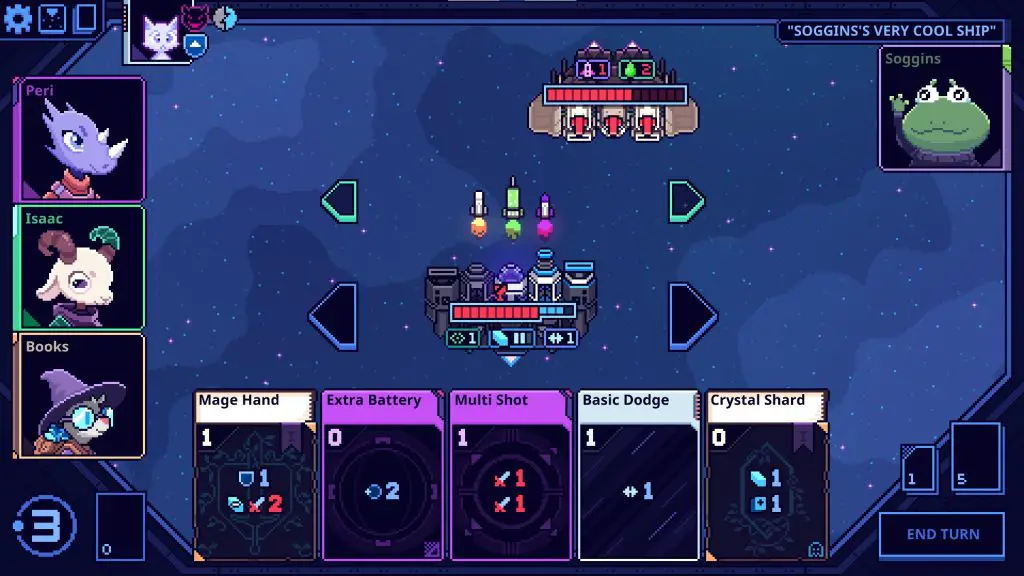
There are a wide variety of rockets and drones to discover. Some of my favorites include the homing rockets and the jupiter drones. While the homing rockets might be pretty self explanatory, the jupiter drones add an interesting element to combat. These specific drones will replicate any attack that your ship takes. That means having one jupiter drone out will double all of your best attacks. Just imagine having 3 or 4 of them in combat at one time.
Bottom Row
Finally, let’s talk about your ship in combat. Your ship has a display of your health, shields, and any status effects you may have. You will also see arrows on either side of your ship when you have some mobility stored up.
Similar to most deckbuilding games, each turn you are going to draw a set number of cards from your deck. Each card is going to have a different energy cost to play it. You have a base of 3 energy to play those cards with. You can also see at the bottom of the screen you draw, discard, and exhaust piles. All of which can be viewed at any time.
Deck
The cards in your deck are going to be based on the 3 crew members that you brought with you. So, experimenting with different combinations of crew members is a big focus of the game. Most cards are going to fit into 3 basic categories: attack, defense, or move. Using an attack card will fire a blast from your cannon to do damage to the enemy ship. A defensive card will add shields to your ship so you don’t take damage during the enemy’s turn. Or at least mitigate the incoming damage. The movement cards though are what differentiates Cobalt Core from a lot of other games in the genre.

Movement
You can use the movement cards to dash back and forth in your row. This allows you to line up the perfect shot or dodge a fatal incoming attack. Not a lot of other deckbuilding games use cards in this third category. They typically stop with the attack or defend options. These movement cards add an extra layer of strategy to the game that really makes it enjoyable. On top of that, there are even different types of movement.
You can build up movement to be able to use it when needed, or you can use dash cards, which give you an instant shift in one direction or the other. Knowing when to move and where is a big key to a successful battle.
Rewards
After successfully defeating an enemy ship, three cards will be revealed to you. You can either pick one to add to your deck or pass. From this screen, you can also view the upgrade options for each of the cards to help make your decision. Depending on the level of the enemy, you might also get a selection of three artifacts to pick from as well. You can always pass on the artifacts, but they tend to have a pretty big effect on the success of your run.
Victory
At the end of a successful run, you will be able to pick one of your crew members to restore a fragment of their memory. After enough successful runs, hopefully you will be able to piece together what caused the time loop in the first place. You will also see a summary where you can review all the cards and artifacts you collected during that playthrough.
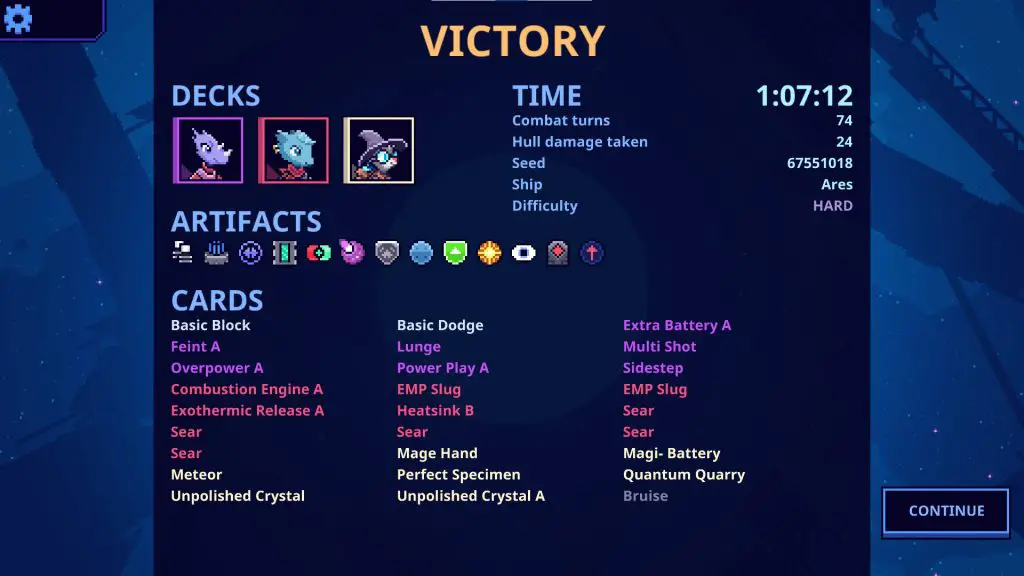
Items
Cobalt Core has a wide variety of different cards, artifacts, and even some specialty items that you can find only at events. Like creating a non-targetable zone in the middle of your ship. Let’s talk about some of the different cards and artifacts you might see.
Cards
As mentioned before, the cards in your deck are going to be specific to the characters that you bring in the ship. Each crew member has 20 or more cards that are unique to them. There isn’t very much overlap between character cards. So you could run into some challenging circumstances if you don’t have a character with strong attacks or someone who specializes in defensive cards.
Each card has two upgrade options to pick from. This can be done at the repair yards throughout your journey. Some battles might even offer you pre-upgraded cards as a reward. These upgrade options usually range from decreasing the cost of the card or increasing the ability of it, such as increasing the damage value or allowing a movement card to be able to flip in which direction your ship will move. Cobalt Core definitely encourages experimentation when it comes to the crew and the cards.
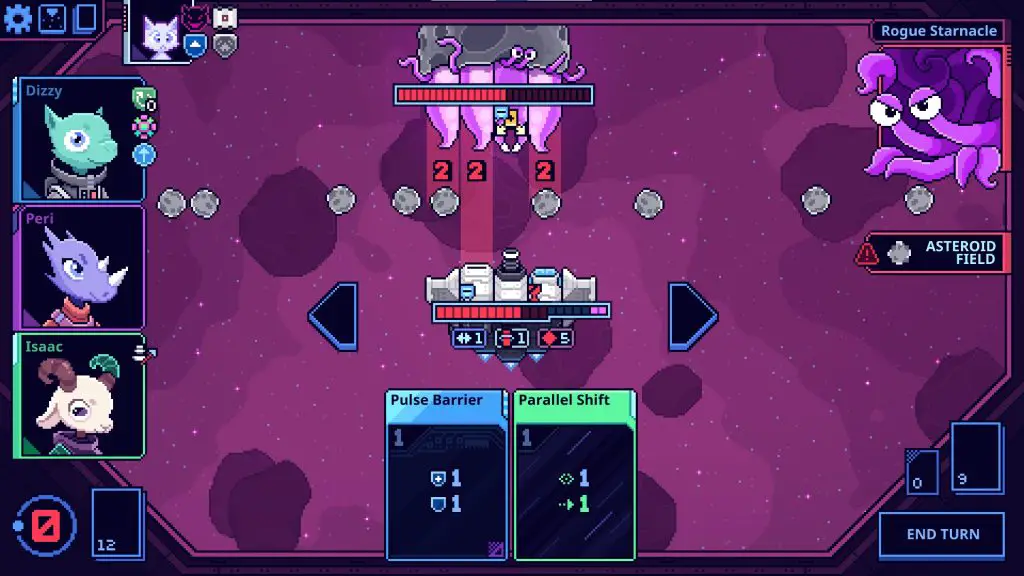
Artifacts
The artifacts in Cobalt Core have mostly passive abilities that improve your ship in some way. This ability will remain for the rest of the run. There are two different kinds of artifacts that will be available. The ones that are specific to your ship and the ones that are specific to your crew. Yes, just like the cards, you can retrieve artifacts that apply passives specifically to each crew member. The ship artifacts are not all generic either. There are specific ones for the particular ship you are using as well.
One ship has an artifact that creates retractable wings. If you did not use all of your energy that turn, then the wings of the ship will retract and become non-targetable during the enemy’s turn. There is another ship that has two cannons which you can alternate between. With a specific artifact, you are able to turn both cannons on at the same time to double your firepower.
The same goes for the character-specific artifacts. One character has an artifact that allows you to destroy drones in the mid-row to gain additional energy, while another gives you additional energy every turn but at the risk of overheating your ship if not properly managed.
Codex
Lastly, I wanted to mention the extensive codex that the developers included in the game. This is not something that I see in very many games. Sure, there is a summary at the end of a run to see how much time it took, what cards you used, etc., but the codex has so much extra information.
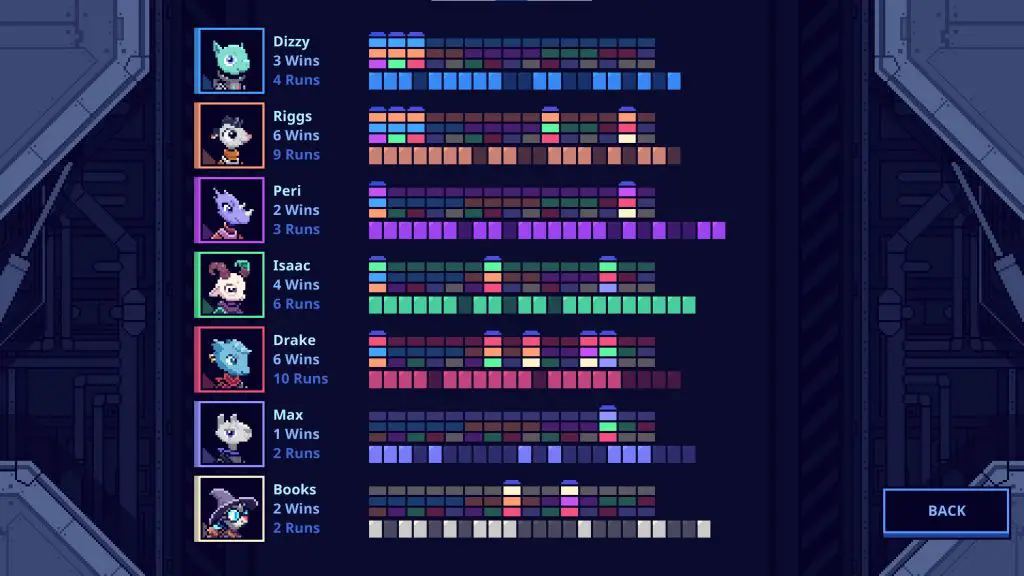
It is a summary of everything you have done so far. You can view your overall progress, such as cards and artifacts found. There is a section for run history. Here, you can view every run you have made. It lists the date, ship, crew, and whether or not it was a successful run.
In the log book you can see a more graphical view of how many wins and total runs you have made with each character. It also shows you what crew combinations you have tried so far. There are even sections to review each individual card and artifact that you have unlocked. There is just so much more information provided than what you see in other games. It really pushes me to want to collect everything and try every combination just to complete the data in the codex.
Visuals
I did want to stop for a moment to talk about the visuals of Cobalt Core before wrapping things up. I am sure that you can tell by the screenshots that this game is very bright and colorful. All of the characters come across as cute or childish. That might deter some players.
Don’t let the lighthearted aesthetics fool you, though. There is a lot of depth hidden underneath. As I am sure you can tell from everything else, I had to say about the game. Truthfully, I didn’t mind the brighter colors and adorable characters. They are a nice break from a lot of darker-themed games I have played recently.
Conclusion
So, after all that, is the game worth picking up? Absolutely! Cobalt Core has a lot of tactical depth with a refreshing new movement element that we don’t really see in the genre. All the character interactions are enjoyable to experience, and their specialized cards strongly encourage replayability. There was a lot of thought that went into making each card set unique, and it really shows.
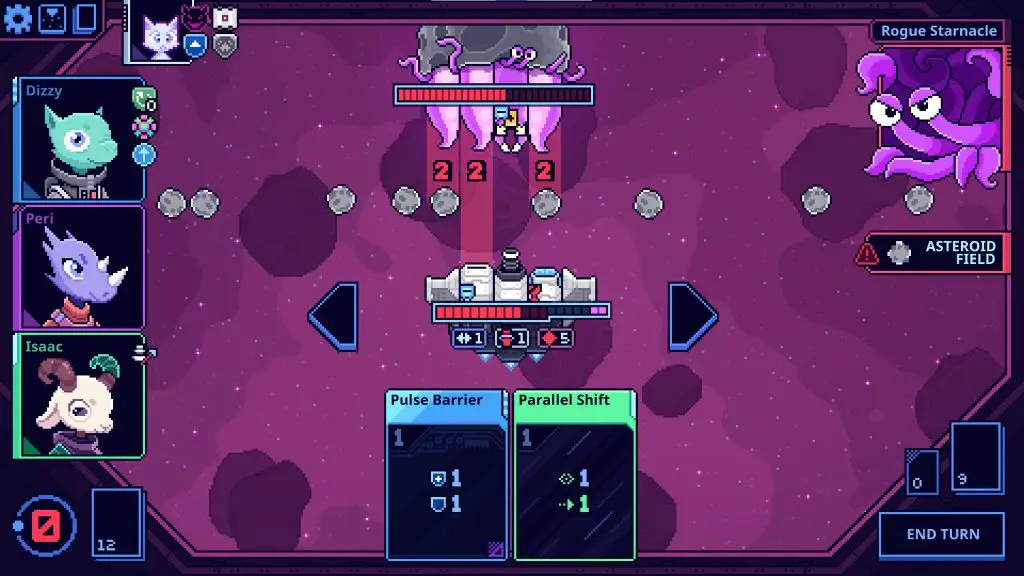
I really like that the gameplay loop makes sense thematically. The characters are literally stuck in a time loop. On top of that, the biggest thing that keeps me playing is simply filling out the codex. A lot of games include a log to review all the cards that you have used, but Cobalt Core takes it to the next level. The fact that I can review every single run and it keeps track of each combination of characters is just remarkable to me. It is practically daring me to try them all.
Cobalt Core is out now for PC over on Steam or for the Nintendo Switch. Personally, I love it on my Steam Deck.
Thank you to the developer, Rocket Rat Games, for providing us with a review key.


